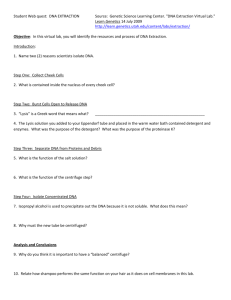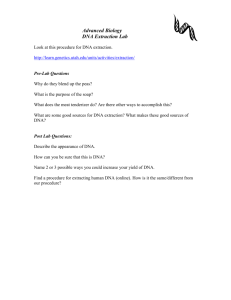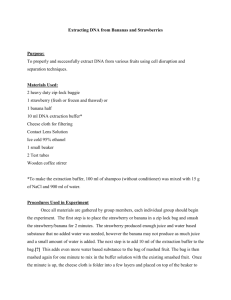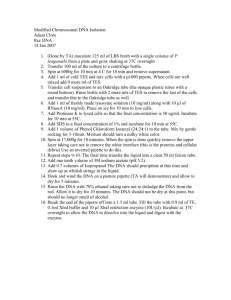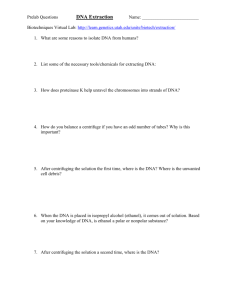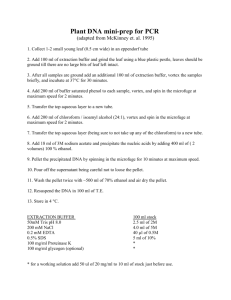DNA Extraction from Strawberries
advertisement
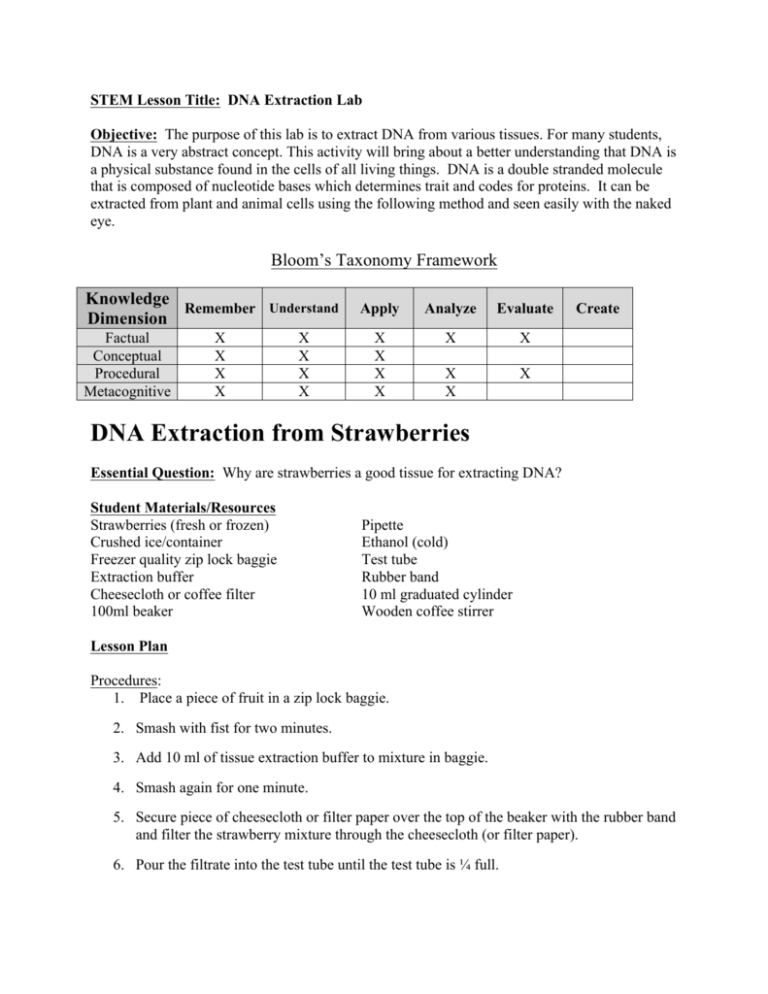
STEM Lesson Title: DNA Extraction Lab Objective: The purpose of this lab is to extract DNA from various tissues. For many students, DNA is a very abstract concept. This activity will bring about a better understanding that DNA is a physical substance found in the cells of all living things. DNA is a double stranded molecule that is composed of nucleotide bases which determines trait and codes for proteins. It can be extracted from plant and animal cells using the following method and seen easily with the naked eye. Bloom’s Taxonomy Framework Knowledge Remember Dimension Factual Conceptual Procedural Metacognitive Understand Apply Analyze Evaluate X X X X X X X X X X X X X X X X X Create DNA Extraction from Strawberries Essential Question: Why are strawberries a good tissue for extracting DNA? Student Materials/Resources Strawberries (fresh or frozen) Crushed ice/container Freezer quality zip lock baggie Extraction buffer Cheesecloth or coffee filter 100ml beaker Pipette Ethanol (cold) Test tube Rubber band 10 ml graduated cylinder Wooden coffee stirrer Lesson Plan Procedures: 1. Place a piece of fruit in a zip lock baggie. 2. Smash with fist for two minutes. 3. Add 10 ml of tissue extraction buffer to mixture in baggie. 4. Smash again for one minute. 5. Secure piece of cheesecloth or filter paper over the top of the beaker with the rubber band and filter the strawberry mixture through the cheesecloth (or filter paper). 6. Pour the filtrate into the test tube until the test tube is ¼ full. 7. Slowly pipette the cold ethanol (that has been sitting on ice) into the test tube (until ½ full) to form two layers. 8. At the interface of the two layers, you will see the DNA precipitate out of the solution. Carefully spool the DNA onto the wooden stirring rod. Mammalian DNA Extraction Essential Question: Why is testicular tissue a good specimen for extracting DNA? Student Materials/Resources Testes (fresh or frozen) Crushed ice Mortar and pestle (on ice) Extraction buffer (cold) SDS (sodium dodecyl sulfate) Pipet Test tube 2M NaCl (cold) Ethanol (cold) Centrifuge Centrifuge tube/cap 10 ml graduated cylinder Stirring rod Microcentrifuge tube Lesson Plan Procedures: 1. Obtain a small piece of tissue (about 2-3mm ) and place it in the mortar sitting on ice. 2. Add 1 ml of extraction buffer (cold) and 3 drops of SDS to the mortar containing the tissue. Grind the tissue with the pestle. Always keep the mortar on ice. Be careful not to let the ice melt into the mixture. 3. Transfer the entire slurry into the centrifuge tube and add twice the volume of NaCl (cold). 4. Cap and shake the tube for two minutes. 5. Centrifuge the tube for 7 minutes (do not operate unless under the direct supervision of the teacher because the machine must be balanced). 6. After centrifuging, there will be two layers: a bottom precipitate pellet and an upper liquid supernatant containing the DNA. Carefully pipette the upper aqueous layer into a test tube – do not stir up the bottom layer! 7. Hold the test tube containing the DNA supernatant at a 45 degree angle and slowly add the cold ethanol to form a top layer. 8. Carefully spool the DNA onto the stirring rod and transfer it to the micro centrifuge tube. Safety Precautions: Wear safety goggles and never have food or drink in activity area. Teacher Materials/Resources: Since testicular tissue has a high nucleus to cytoplasm ratio, this tissue yields a high amount of DNA. Contact your local spay and neuter clinic in advance to obtain specimen. Solutions: Extraction Buffer (for strawberry DNA extraction): Combine 50ml liquid dishwashing detergent and 15g NaCl diluted with 950 ml water. Extraction Buffer (for mammalian DNA extraction): Combine .87g NaCl and 10 mls of 0.1 EDTA (ethylenediamine tetraacetic acid) diluted to 100 ml with distilled water. SDS (sodium dodecyl sulfate) – 15% Solution Lesson Extensions/Assessments -Experiment with different types of tissues (banana, onion, even human cheek cells) -Experiment with different concentrations of salt and detergent Adapted from Berry Full of DNA by Diane Sweeny for Biology: Exploring Life by Prentice Hall
